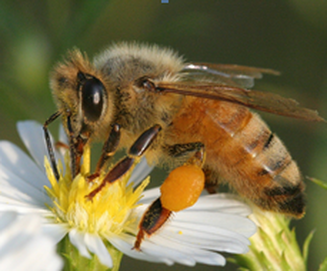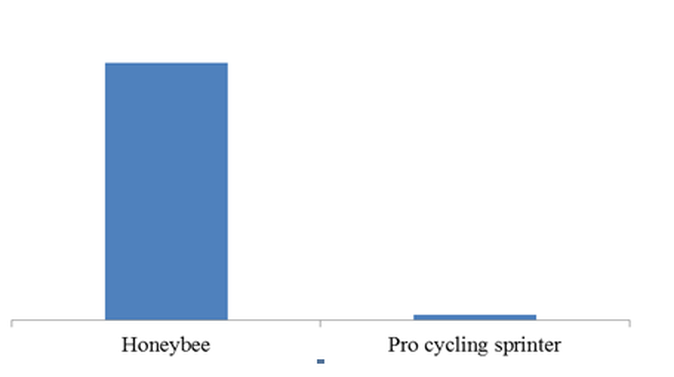|
“The more you fly, the sooner you die” Synopsis for Dr. Michelle Elekonich’s colloquium talk, “It’s not the age, it’s the mileage: honey bee behavior, stress, and aging The second colloquium talk of the semester brought us into the world of insect physiology, as Dr. Michelle Elekonich presented research carried out by her lab on the influence of behavior on the aging process in honeybees. Much of the work presented in the talk centered around the role of reactive oxygen species (ROS) on the degradation of cellular machinery, leading to an eventual decline in function, and ultimately death. ROS are produced through metabolic reactions, with production increasing with higher metabolic output. The thrust of these findings, as they are applied to honeybees, were summarized during the talk with the colorful slogan, “the more you fly, the sooner you die.” Undoubtedly, many in the audience were mentally applying findings from these studies of senescence in bees to schemes for extending their own longevity. However, before committing to a long life of sloth and açaí berries, it is worth looking more in depth at these studies of ROS and its effects in honeybees. ROS, such as superoxide and hydroxyl radicals are produced as intermediate steps during metabolic reactions, and can degrade important molecules within the cell, such as DNA and lipids. ROS are normally kept from damaging cellular structures by enzymes with antioxidant functions, such as catalase, as well dietary antioxidants, such as ascorbic acid (vitamin C). However, different factors can impede cells from quenching all ROS that are produced, such as oxidative stress from ionizing radiation, or extremely high metabolic levels that overwhelm antioxidant functions within the cell. There have been many studies implicating ROS in advancing aging processes at the cellular level in many different animal systems, including insects. One of the unique properties of studying this process in honeybees is the flexibility of the lifespan of the bees, which is mediated by behavioral activities, and not limited to a pre-determined death. For the most part, adult honeybees are not reproductive, so there is no single event where biological imperatives are met, and cellular functions can just shut down. Therefore natural selection is likely acting to increase the longevity of these non-reproductive bees in the face of great oxidative stress from extremely high metabolic rates. Except for the queen, female honeybees within a hive go through different life stages, beginning their adult lives tending to duties within the hive, and culminating in foraging activities outside of the hive. As bees transition from peaceful indoor work to intense daily foraging for nectar and pollen, they are subject to a dramatic increase in cellular metabolism and stress. Dr. Elekonich’s lab performed experiments measuring the antioxidant levels in foraging bees before and after daily foraging activities, and found that only young bees show increases in antioxidant levels in response to higher metabolism, while older bees do not (Williams et al. 2008). These findings indicate that as foraging bees age, their production of antioxidant enzymes becomes reduced, and with it the ability to handle ROS production from flight activity. This likely increases oxidative damage to flight muscles and increases rates of senescence. This hypothesis was further supported by experiments testing the flying abilities of different aged bees by observing them hovering within low-density atmospheres (Vance et al. 2009). Flight is increasingly difficult for insects in gasses of lower densities. To achieve this, honeybees were flown in different atmospheres, where the nitrogen content of normal air was replaced incrementally with helium. Using high-speed photography, the mechanics of flight could be observed and quantified. The results of this experiment show the wing beats of older forager bees have reduced amplitude relative to normal aged foragers. In nature, this could result in bees not making the flight back to the hive, or being susceptible to predators. Some of the measured reduction in antioxidant response of forager bees may be attributed to patterns of gene expression that change as bees transition from nurses to foragers (Margotta et al. 2013). By manipulating the age at which bees transition from nurse to forager, Dr. Elekonich’s lab was able to show that it is the transition from nurse to forager that induces the greatest change in gene expression patterns, rather than age. The cumulative picture that is painted from these studies is that foraging bees are worked to death, as the metabolic demands of prolonged flight take their toll on the flight muscles. By contrast, remaining in the hive as a nurse precludes the bees from behaviors that are inherently bad for their bodies. It would be wonderful to be able to apply these results directly to humans, and one could imagine that health initiatives would change dramatically. Reduce your metabolic output for a long and healthy life: avoid the gym at all costs. Use the elevator, stairs are for emergencies only. Reinstate required afternoon naptime. Robots would do all of our yard work, while we sip ginseng tea in padded armchairs and type review articles with ergonomic keyboards. No more field work. Alas, these studies should not be used to justify immobility, as the metabolic processes producing oxidative stresses in foraging bees occur at orders of magnitude higher than anything humans are capable of producing. The closest we could come to drawing parallels to human behavior would be that it is probably a bad idea to try to sprint a marathon every day for the rest of your life. Aside from that, these studies offer new insight into the role of behavior on the onset of senescence in insects, at least. References Margotta, J. W., G. E. Mancinelli, A. A. Benito, A. Ammons, S. P. Roberts, M. M. Elekonich, 2013. Effects of flight on gene expression and aging in the honey bee brain and flight muscle. Insects. 4: 9-30. Vance, J. T., J. B. Williams, M. M. Elekonich and S. P. Roberts, 2009. The effects of age and behavioral development on honey bee (Apis mellifera) flight performance. The Journal of Experimental Biology. 212: 2604-2611. Williams, J. B., S. P. Roberts, M. M. Elekonich, 2008. Age and natural metabolically intensive behavior affect oxidative stress and antioxidant mechanisms. Experimental Gerontology. 43: 538–549. About Alan:
Alan Leslie is a Ph.D. candidate in the Lamp Lab, studying aquatic macroinvertebrates and their effects in regulating ecosystem functions. His research project is focused on determining the effect that burrowing aquatic invertebrates have on nutrient transport in agricultural drainage networks. Comments are closed.
|
Categories
All
Archives
June 2024
|
Department of Entomology
University of Maryland
4112 Plant Sciences Building
College Park, MD 20742-4454
USA
Telephone: 301.405.3911
Fax: 301.314.9290
University of Maryland
4112 Plant Sciences Building
College Park, MD 20742-4454
USA
Telephone: 301.405.3911
Fax: 301.314.9290




 RSS Feed
RSS Feed




